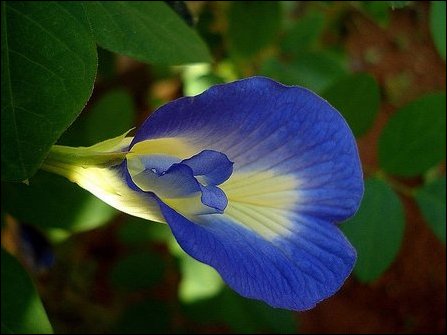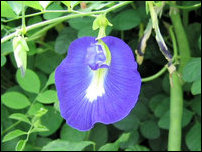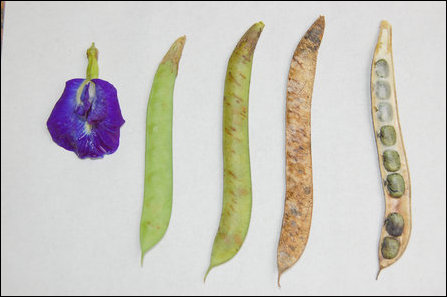Know the Etymology: 184
Place Name of the Day: Tuesday, 01 February 2011
Minni-ni'raignchaan
மின்னி நிறைஞ்சான்
Miṉṉi niṟaiñcāṉMinni+ni'raignchaan
The place abounding with Minni plant or creeper
| Minni |
1. Also called Karung-kaakka’nam, Kaakkaddaan, Karuvi’lai, Kanni, Uyavai: Mussel-shell creeper, Butterfly Pea, Clitoria ternatea-typica (Tamil, Madras Tamil Lexicon); 2. Minnip-paya’ru, Neerp-paya’ru: a leguminous plant (Tamil, MTL, Winslow); Kataro’lu, Katarodu: The Sinhala name for Clitoria ternatea; Aparaajita and Vish’nu Kiraantaa are synonyms in Sanskrit |
| Ni’raignchaan |
The place abounding with (Eezham Tamil usage in place names); From Ni’rai: (verb) To become full, abound; (noun) completion fullness; Ni’raiya: (adverb) Abundantly; Ni’raintha, Ni’raigncha: (adjective) Full of, abounding with (Tamil, Dravidian Etymological Dictionary 3682). The ‘An’ suffix is peculiar to Eezham Tamil place names.
|

Minni/ Karung-kaakka’nam/ Karuvi’lai/ Clitoria ternatea-typica [Image courtesy: Aruna at ml.wikipedia]

Ve’n-kaakka’nam/ Clitoria ternatea-alba [Image courtesy: www.botanic.jp/ plants- ta/chouma.htm]

Clitoria ternatia-typica: Minni/ Karungkaakka’nam/ Karuvi’lai, flower, foliage and pods [Image courtesy: www.botanic.jp/ plants-ta/chouma.htm]
Minni is one of the Tamil names of the creeper Clitoria ternatea-typica, which is also known by several other names such as Karung-Kaakka’nam, Kaakkaddaan, Karuvi’lam, Changku-pushpam, Kanni, Uyavai etc.
There are two varieties of the Kaakka’nam creeper: Cheruvi’lai or Ve’n-kaakka’nam which bears white flowers and Karuvi’lai or Karung-kaakka’nam that bears deep blue to violet flowers.
The creeper and its flower are widely mentioned in Changkam Tamil literature:
“பீலி ஒண் பொறிக் கருவிளை” (குறுந்தொகை 110:4)
Peeli o'n po'rik karuvi'lai (the flower of Karuvi’lai resembling peacock feather; Ku’runthokai 110:4)
“கண் எனக் கருவிளை மலர” (ஐங்குறுநூறு, 464)
Ka'n enak karuvi'lai malara (when the Karuvi’lai blossoms like an eye; Aingku’runoo’ru, 464)
Known as Mussel-shell creeper or Butterfly Pea, this leguminous plant is found in several parts of the world.
It can grow even in calcareous soils and can tolerate excess rainfall or excess draught. That is how this creeper is abundantly found in Mannaar and even in the islands like Kachchatheevu where there is no groundwater and its growth depends only on scanty rainfall.
The creeper is a nutritious fodder and is useful in enriching the soil by nitrogen fixing.
The edible flower of the creeper is used as an exotic colouring agent in the cuisine of Southeast Asia. In some parts of the world the creeper is grown as an ornamental plant.
It is an important herb of wide-ranging use in indigenous medicine. Modern studies have shown that the contents of the creeper, especially of the flower, are useful in the treatment of inflammation, wounds, piles and arthritis to cancer and leukodema. The seeds are recognized for its purgative effect.
Another leguminous plant Minnip-paya’ru or Neerp-paya’ru is also called by the name Minni. The botanical identification of this plant is not available.
Minni-ni'raignchaan is a place near Vangkaalai in the Maanthai West Division of Mannaar district. People of the area recognize the mound in this place as a locality abounding with various types of medicinal herbs.

Flower, pods and beans of Minni/ Karungkaakka’nam/ Karuvi’lai [mage courtesy: Tux the penquin, Wikimedia Commons]
The flood plains/ The area where water flows in a spread way. This is a place in the delta of Mahaweli River where Koddiyaar-aa’ru, Verukal-aa’ru and Valavachaar-aa’ru make a flood plain; Moothoor division, Trincomalee district. There is another Paravip-paagnchaan, which is also flood plain in Ki’linochchi GS area of Karaichchi division of Ki’linochchi district. Paravi (adverb of) Paravu: To spread (Tamil, DED 3949); Paay: (verb) To flow or to spread as water (Tamil, DED 4088); Paagncha: (adjective): flowing; Paagnchaan: (Eezham Tamil noun formation in place names) The area where water flows in a spread way.
Eeddi-mu’rignchaan: The place where the Eeddi trees (Thuvarai/ Dalbergia latifolia) fell. This is a village in Oddusuddaan division of Mullaiththeevu district
Panai-nin’raan: The locality where palmyra palms stand; this is a village in Oddusuddaan division of Mullaiththeevu district
Thikil-padarnthaan: The locality found spread by Thikkai or Thikai herb: This is a place in Vavuniya North division of Vavuniyaa district (noted by Aruna Selladurai p 115)
First published: Tuesday, 01 February 2011, 07:04
Previous columns:










